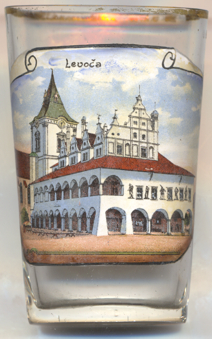

|
| SLOVENSKO | SLOVAKIA |
| Prešovský kraj | Prešov region |
| okres: Levoča |
Levoča (previously in Hungarian: Lőcse, in German: Leutschau) is situated at an elevation of 570 m at the northern edge of the basin Hornádska kotlina at the foot of the Levočské vrchy mountains to the north, about 55 km west of the regional capital Prešov and about 350 km northeast of the country's capital Bratislava. The stream Levočský potok (west of the town centre) is a tributary of the Hornád river. The municipality of Levoča has a population of about 14,800 (2018).
 Levoča is located in the historical region of Spiš, which was inhabited as early as the Stone Age. In the
11th century, this region was conquered and, subsequently, became part of the Kingdom of Hungary and remained such
until 1918. After the Mongol invasions of 1241/1242, the area was also settled by Germans. The town became the capital of
the Association of Spiš Germans, with a form of self-rule within the Kingdom of Hungary. The oldest written reference
to the city of Levoča dates back to 1249. In 1317 Levoča received the status of a royal town. In the
15th century the town, located on an intersection of trade routes between Poland and Hungary, became a rich center of
commerce. It exported iron, copper, furs, leather, corn, and wine. At the same time the town became an important cultural
centre. In the 17th century, Levoč was a centre of the Protestant Reformation. During the anti-Habsburg
uprisings of the 17th century the town began to decline. The economic importance of the town was further diminished in
1871 when the important new Košice – Bohumín
Railway was built just 8 km to the south, bypassing Levoča and going through the nearby town of
Spišská Nová Ves. Later, in 1892, only a spur line was built from Spišská Nová Ves
railway station to Levoča. After the Treaty of Trianon and the dismantling of the Kingdom of Hungary, the city became
part of the newly formed Czechoslovakia and its Slovak name Levoča was formally adopted.
Levoča is located in the historical region of Spiš, which was inhabited as early as the Stone Age. In the
11th century, this region was conquered and, subsequently, became part of the Kingdom of Hungary and remained such
until 1918. After the Mongol invasions of 1241/1242, the area was also settled by Germans. The town became the capital of
the Association of Spiš Germans, with a form of self-rule within the Kingdom of Hungary. The oldest written reference
to the city of Levoča dates back to 1249. In 1317 Levoča received the status of a royal town. In the
15th century the town, located on an intersection of trade routes between Poland and Hungary, became a rich center of
commerce. It exported iron, copper, furs, leather, corn, and wine. At the same time the town became an important cultural
centre. In the 17th century, Levoč was a centre of the Protestant Reformation. During the anti-Habsburg
uprisings of the 17th century the town began to decline. The economic importance of the town was further diminished in
1871 when the important new Košice – Bohumín
Railway was built just 8 km to the south, bypassing Levoča and going through the nearby town of
Spišská Nová Ves. Later, in 1892, only a spur line was built from Spišská Nová Ves
railway station to Levoča. After the Treaty of Trianon and the dismantling of the Kingdom of Hungary, the city became
part of the newly formed Czechoslovakia and its Slovak name Levoča was formally adopted.
The old town centre is mostly preserved and still is surrounded by most of its ancient walls. In 2009, Levoča, was listed as a UNESCO World Heritage site (see list) in addition to Spiš castle, Spišské Podhradie/Spišská Kapitula and Žehra (which had been listed already in 1993).
The  old town hall [left, no. 3725]
was originally built in the 15th century. The Gothic building was destroyed in 1550 during a fire and only fragments of
the original walls were preserved. The town hall in an existing form was built in 1615 in Renaissance style and was later
reconstructed in 1893–1895.
old town hall [left, no. 3725]
was originally built in the 15th century. The Gothic building was destroyed in 1550 during a fire and only fragments of
the original walls were preserved. The town hall in an existing form was built in 1615 in Renaissance style and was later
reconstructed in 1893–1895.
[https://de.wikipedia.org/wiki/Levoča, https://en.wikipedia.org/wiki/Levoča;
https://en.wikipedia.org/wiki/Old_Town_Hall_(Levoča)]
![[scale]](lineal.jpg)